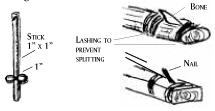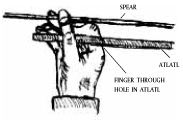Alaska Science Camps, Fairs & Experiments
ANKN is a resource for compiling and exchanging information
related to Alaska Native knowledge systems and ways of knowing. We
are pleased to create and distribute a variety of publications
that assist Native people, government agencies,
educators and the general public in gaining access to the knowledge
base that Alaska Natives have acquired through cumulative experience
over millennia.
TO ORDER THIS PUBLICATION:
Contact the ANKN
offices at 907-474-1902 or email uaf-cxcs@alaska.edu.  Spear
Throwing Spear
Throwing
In certain seasons in certain water
conditions seals sink when shot. Losing a seal is always a
possibility. Even today, many people living in the mouths of Alaska's
rivers spear seals rather than shoot them with guns so they can be
retrieved before sinking.
For centuries, people experimented with spears and throwing sticks
called atlatls. A precise science has been developed by seal hunters
to obtain the greatest distance and accuracy. There are three
variables in throwing a spear:
- The hunter
- The spear
- The atlatl
|
  
|
Experiment with different atlatls. Make a long, a short,
and a medium length atlatl. Traditional atlatls look
something like those on the left:
You can make a simple one like this:
On the end of the atlatl is a pin that was traditionally
made of bone or a tooth. You can make it from a nail while
experimenting.

|
 Hollow
the tip of the spear so the nail will seat in the end of the spear
and not slip off. Hollow
the tip of the spear so the nail will seat in the end of the spear
and not slip off.
Throw a spear ten times measuring each throw for distance.

Throw the spear ten times measuring for accuracy (How many times
you can get the spear within a 10' circle from 50'.)
Which atlatl gives the greatest distance, the long, medium, or
short one? The best accuracy?
Now experiment with different spears. Try a long spear, a short
one and a medium length spear.
Try a spear with feathers in the back.
Try a spear with a weight in the front.
Try a spear with feathers in the back and weight in the front.
What is the most effective combination of altatl length, spear
length and spear design?
Experiment with different weights on the end of the spear. Put on
a heavy, a medium, and a light weight. (I test by wrapping with
strips of lead.) Which is most effective for distance and
accuracy?
With your ability to throw a spear, would you eat supper tonight
or go hungry?
I have always wondered if the long slim shape of the Aleut
bentwood hat was to keep the hunter from knocking his hat off when he
threw a spear.
  Traditionally,
the length of the atlatl is from the elbow to the first knuckle. Traditionally,
the length of the atlatl is from the elbow to the first knuckle.
The length of the spear is from the elbow of one arm to the
outstretched finger of the other arm.
Another person bigger or smaller than you should try the
same
experiments with the same atlatl. Are the results the same for a
different size hunter, or does the size of the "perfect" atlatl vary
with the size and strength of the hunter? Do left-handed people have
an advantage or disadvantage.
Again, there are three variables:
- The hunter
- The atlatl
- The spear
Long ago, hunters threw while sitting in a kayak. Nowadays, they
stand up in the front of a large boat.
Compare your distance and accuracy while sitting vs. the results
while standing. Use the same atlatl and spear. From which position
can you throw farther? Is this true for other hunters too?
This enjoyable experiment has very important conclusions.
|